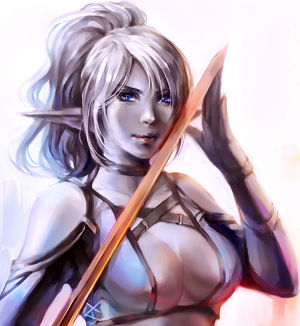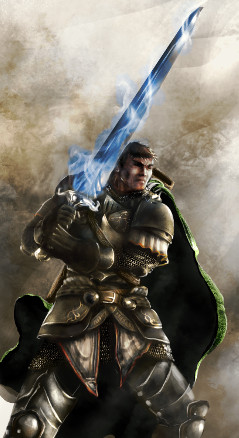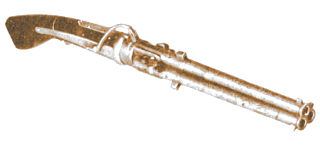Since the dawn of history, people have employed the use of those most devious tools of ruinous invention: weapons. In short, a weapon is tool, instrument, or implement used to inflict harm. In desperate hands anything can be a weapon—a stick, a rock, a plate, a rope, or just about any object that can be swung or thrown. But generally speaking, weapons are those things specifically designed to be weapons. These include traditional weapons, powered melee weapons, firearms, mechanical guns, and cannons and artillery.
Traditional Weapons

Swords are the most iconic of traditional weapons, being versatile, powerful, and nimble. Although many swords are now mass produced for military use, good quality swords are still forged with great craftsmanship and skill. Swords include shortswords, broadswords, rapiers, cutlasses, sabers, scimitars, and falchions, among others. The falcata is sleek sword with a forward curved blade popular with the Scaithi. Soldiers and officers alike are issued regulation sabers, close-in shortswords, or rifle-mounted bayonets to use when ammunition runs out or a gun jams, and no mercenary or adventure would be caught in battle without a trusty blade by his or her side.
Spears and pole-arms are also versatile and effective weapons, being long wooden poles with a spearhead, axe, or blade at the end. Among pole-arms other than spears, halberds, glaives, berdiches, and war-scythes are among the most popular. Axes, halberds, and spears tend to be more popular with Dworghs and Ogrum than with humans or Eldren.
Traditional weapons also include bows and crossbows. These traditional ranged weapons existed before the advent of firearms, and continue to be useful weapons of war even to the current age. Bows are especially popular among Eldren and Scaithi, as well as hunters and scouts the world over, although crossbows have been largely displaced by firearms.
Traditional weapons may be “spell-forged” or “mage-forged,” meaning that magical empowerments were employed during the forging process to make the blade stronger, sharper, or carry some innate property. Advanced alchemical alloys may also be used to forge blades, such as cobalt steel, cinnabar steel, viridian steel, starshard, or argent steel (which is especially useful against vampires and undead). Further augmentation is possible with vizstones empowered by mages or sorcerers, or blessed by theurges, to inflict greater damage or produce marvelous effect, such as erupting into flames, becoming molten-hot, or shooting arcs of lightning.
Powered Melee Weapons

Powered melee weapons are those weapons that are similar to traditional weapons, but mechanical augmented in some way. These may also include weapons that are heated, electrified, or energized, or which are actuated by gears, motors, or clockwork components. Powered weapons should not be confused with empowered weapons, which are traditional weapons (or even firearms) that have been magically empowered.
Clockwork swords are a class of sword that use clockworks to extend their function. The flail sword, also called a chain sword, is one of the earliest of these mechanically actuated weapons. The buzz sword is another kind of clockwork sword, sometimes called a powered sword when driven by a motor. Typically, these swords have a chain of serrated teeth along one or both edges, driven by a clockwork motor in the grip.
Similar to the buzz sword, but significantly more refined, are vibroswords. These swords have powerful oscillator actuators in the hilt, which makes the specially designed blade vibrate. Although the vibration is ever-so slight (mere fractions of an inch), the rate of vibration is several hundred cycles per second.
Heated blade weapons are another kind of powered weapon. While true flaming swords must be empowered by a mage, the heated blade sword has powerful heating elements running down the length of the blade which, when activated, can heat the blade to red or even white-hot temperatures.
Firearms
While guns and cannons have dominated the battlefield since the Age of the Three Realms, armies and fighters still make use of traditional melee weapons. After all, nothing beats a good sword in close combat, and axes and maces, wielded properly, can inflict considerably more damage than a bullet. And they never run out of ammo.

Most guns in use today fire only a single round before needing to be reloaded with gunjuice cartridge and sparkcap, but some multi-chamber and repeating fire weapons exist as well. The most advanced (and rarest) weapons found today are driven by clockworks, pneumatics, or mechanical engines, and can fire dozens of bullets in quick succession.
Older gunpowder firearms, which were in use from the 400s through the 1320s (the War of Tyranny) include matchlocks, springlocks, snaplocks, and caplock firearms, some of which were muzzle loaders and other, later types, breech loaders taking paper cartridges. Gunjuice firearms were only possible with the advent of metallic cartridges and firearms forged to higher pressure tolerances. All gunjuice firearms are either breech loaders or employ some form of automatic loading mechanism.
Single shot pistols, revolving pepperbox pistols, breech-loading rifles, bolt-action rifles, and scatter-shot blunderbusses are among the most common types of firearms, all using alchemical gunjuice cartridges and sparkcaps. More exotic weapons, such as clockwork repeaters, gunjuice-injector repeaters, mechanical drum guns, grinder guns, ripper guns, and turbine guns have all come about thanks to rapid advances across the industrialized nations of the world, ushering in a new and more terrible age of war.
Mechanized Guns
Mechanized guns constitute a new and even more terrifying class of firearms. Although clockwork repeaters and pneumatic repeaters are technically mechanized, true mechanized repeaters are much larger and are not man-portable (except when broken down to carry).

The first pneumatically powered mechanized guns were similar to pneumatic clockwork rifles, but were heavier and more rugged. Cartridges were fed from a belt, drum, or hopper, while others might have a gunjuice injector. Mechanized guns are typically only found on aircraft, ships, juggernauts, bunkers, and fortifications, or can be mounted on traditional cannon carriages.
Drum guns are pneumatically powered, mechanized crank repeaters, with a drum of gunjuice cartridges mounted on top. As the gun fires, the drum rotates to drop the cartridges into the firing chamber. A separate strip of sparkcaps is fed through at the same time, with the gears snapping the sparkcap into place as a hammer strikes, firing the round.
Grinder gun are named such for their similarity to coffee grinders, and the meat grinder effect they have on their victims. The hopper is mounted above the rear of the gun, and the cartridges are dumped into the hopper. As the gun fires, the cartridges fall one after the other into the firing chamber, while the crank pulls a separate strip of sparkcaps through. The crank also drives the hammer, striking the sparkcap to fire the round.
Ripper guns are notably different from other mechanized firearms in that they do not use cartridges, sparkcaps, or even bullets. Instead, bars of lead are fed into the ripper blades, creating sparks that ignite the gunjuice sprayed into the weapon’s combustion chamber. The explosion propels the shredded metal out the gun’s wide barrel in a cone of deadly fire and shrapnel.
Mechanized injector repeaters are basically up-sized injector repeaters. Like other, man-portable injector repeaters, mechanized injector repeaters have a canister or bottle of gunjuice and a small injection pump. When firing, a tiny amount of gunjuice is sprayed into the chamber as the bullet is loaded, then igniting with a sparker, creating an explosion to propel the bullet out the barrel.
Kendes turbine guns are advanced, mechanized injector repeaters that operate by injecting a pulsed steam of gunjuice into a spinning turbine combustion chamber. Bullets are fed in by a metal belt, where pistons then ram each round into the whirling combustion chamber where the exploding gunjuice propels the bullet down the barrel at extreme velocity.
Cannons and Artillery

Today, cannons are deployed everywhere from fortresses, to battlefields, to naval ships, to airships, and aircruisers. There are two basic types of cannons: smoothbore and rifled. Smoothbore cannons are typically forged of wrought iron, and are classified by the weight of the cannonball or shot they fire, such as 6-pounder, 9-pounder, or 24-pounder.
More advanced rifled cannons are classified by the diameter of their bore (the caliber), such as 3-inch, 6-inch, 9-inch, 14-inch, and so forth. All rifled cannons are breech-loaded, using a gungel charge and heavy explosive shell, and are typically sealed with a heavy sliding block.
Cannons are traditionally referred to as guns when mounted on warships, and may be referred to as artillery when used on land.